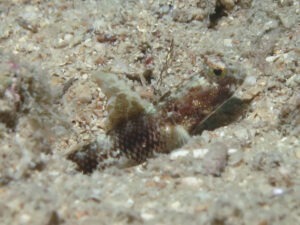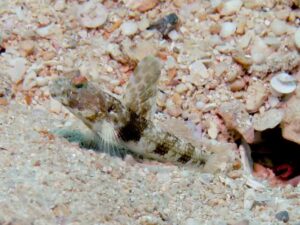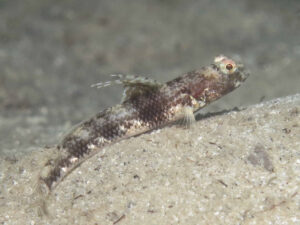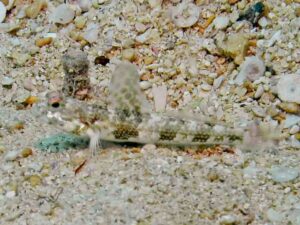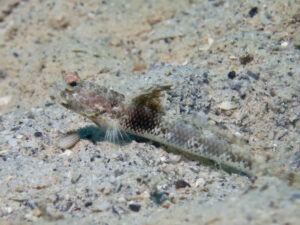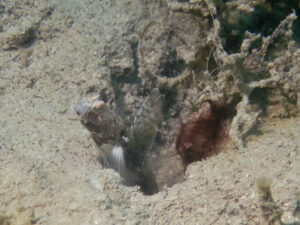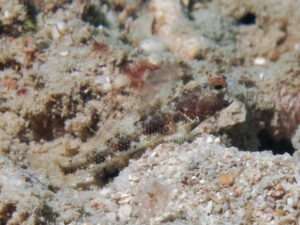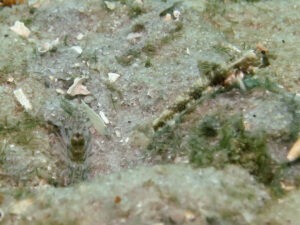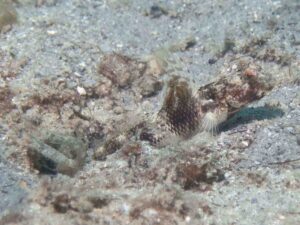Fan Shrimpgoby
Tomiyamichthys latruncularia
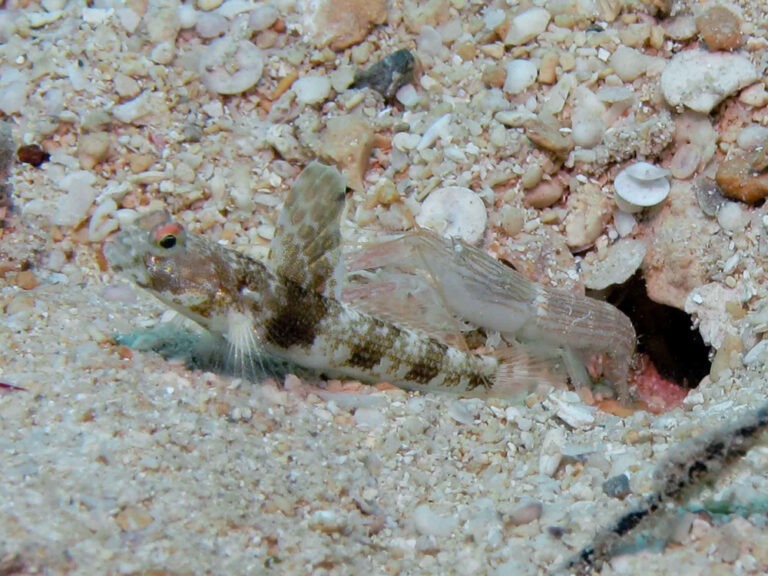
Fan Shrimpgoby
Tomiyamichthys latruncularia
(Klausewitz, 1974)
Description
Body design
A medium-sized goby up to 10 cm in length, although all the individuals we have seen have been much smaller (6cm). Body cream coloured with 5 or 6 broad dark bars that extend down from dorsal saddles. These areas have diagonally alternating pale and dark scales creating an overall dark colour. The cream zones are the same width as the dark and are marked by dark scales making a random pattern. A line of about 8 white patches runs along the lateral body.
Head design
The snout is pale and the upper half of the eye is red. The cheek is marked by brown-edged red spots in three longitudinal rows These show up well when the cheek and gill cover is white, at which time there is a dark line from the eye to the angle of the mandible and another angled forward to the midpoint. of the upper lip. A heart-shaped pale area on the nape has two dark spots behind the eyes. The cheek frequently takes on a dark hue which obscures these features.
Fin design
The first dorsal fin differs between the sexes. In the female, the fin is about twice as high as it is long, and rounded on the top with large dark-edged gold spots. It is usually held upright. In the male, the fin is more triangular with the first three rays extending as filaments beyond the edge of the fin. The second and third rays are as long as the fin is high. It also has dark-edged gold spots. The second dorsal fin is translucent with three rows of brown-gold spots similar to those on the first dorsal fin. the pectoral fin is opaque white at its base becoming transparent with white rays. The caudal fin is transparent with a brown base and radial brown streaks.
Diagnostic features
The first dorsal is distinctive in both sexes.
Similar species
Vanderhorstia papilio has a similar body pattern and gold pots on the head but these extend the full length of the body. It also differs in dorsal fin.
Natural History
Habitat
The Fan Shrimpgoby occupies a range of depths from 2 to 45 m and a range of habitat from silt to fine sand to mixed fine and coarse sand.
At Frazer Island we only found juveniles, on fine silty sand at 14m.
At North East Percy Island it lives on extensive silty sand flats with scattered growth of Halophila minor and Halophila spinulosa at 10 metres.
At Fitzroy Island, it is on bare silty sand at 17m with occasional coral rocks.
At Low Isles they were in a sheltered bay in silty sand at 6m.
In the Solomon Islands, at Ghizo harbour, they were found on clean bare sand, in an area of moderate current at 17m.
Behaviour
The Fan Shrimpgoby sits on the sand at the burrow entrance. They do not prop themselves up high on pelvic fins like other gobies or hover above. They usually sit with the dorsal fin erect and pectoral fins held down.
We have records of four snapping shrimp associations, the Pink Pyjama Snapping Shrimp in mixed coarse sand, the Red Snapping Shrimp on fine sand and the Diagonal barred and Tasselled Snapping Shrimp on silt. This suggests that this goby is comfortable in a wide range of habitats which is a little unusual for a shrimpgoby.
Distribution
Published distribution: Red Sea and Maldives to Karimanjawa, Java Sea
and Lembeh Strait, Sulawesi, Indonesia.
Our records (range extension)
Solomon Islands; Gizo Island
Australia; Frazer Island, Blunt Bay in Percy Islands, Fitzroy Island and Low Isles, Great Barrier Reef.
Associated Shrimp species
Associated Shrimps (four Shrimps)
Diagonal Barred Snapping Shrimp, Alpheus rapacida
Pink Pyjama Snapping Shrimp, Alpheus ochrostriatus
Red Pyjama Snapping Shrimp, Alpheus ochrostriatus
Tasselled Snapping Shrimp, Alpheus species 14

